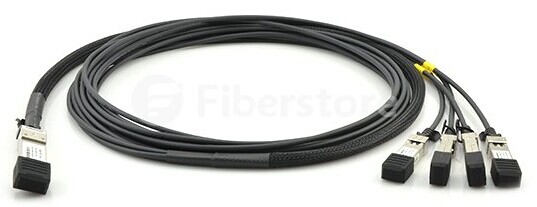With the economics-driven growth of fiber communication networks over the past few decades, there is an increasing demand for cables which can provide a lower-power means for operation on short fiber optic links or short copper connections such as the direct attach cables (DAC) that will be described in this article.
What is DAC
A direct attach cable (DAC) is a fixed assembly that is purchased at a given length, with the connector modules permanently attached to each end of the cable. The direct attach cable is designed to use the same port as an optical transceiver, but compared with optical transceivers, the connector modules attached to the DAC leave out the expensive optical lasers and other electronic components, thus achieving significant cost savings and power savings in short reach applications.
Types of DAC
According to the cables used, the direct attach cables include copper cable assemblies and fiber optic cable assemblies. Besides, DAC cable assemblies can also be classified into 10G SFP+ cables, 40G QSFP+ cables, and 120G CXP cables according to the data rate supported by different connector modules.
In addition, direct attach copper cable can be divided into active and passive versions. In the active direct attach copper cable, there are signal processing electronics in the modules to improve signal quality and provide a longer cable distance. Otherwise, direct attach copper cable is considered passive. However copper cable is heavy and bulky, in order to overcome the disadvantages, active optical cable (AOC) assembly is booming in the market. AOC provides more advantages, such as lighter weight, high performance, low power consumption, low interconnection loss,etc. Take Cisco QSFP-4X10G-AOC10M compatible QSFP+ to 4SFP+ breakout AOC for example, it offers a very cost-effective way to establish a 40-gigabit link between QSFP port and SFP+ port of Cisco switches because of the low power consumption and high performance.
What’s more, we can also divide the DAC according to the number of connectors on the end of the cable. Most DAC assemblies have one module on each end of the cable. But there is a special kind of DAC assembly which may have 3 or 4 modules on one end of the cable. For instance, Cisco QSFP-4SFP10G-CU1M compatible QSFP+ to 4SFP+ passive breakout copper cable from Fiberstore has a single QSFP+ module rated for 40-Gbps on one end and four SFP+ modules, each rated for 10-Gbps, on the other end.

Directions for Use
A direct attach cable is used to connect one mobility access switch with another when forming a stack. Let’s take the 10G SFP+ copper connection components for example. When a SFP+ port supports a direct attach connection, all you need to do is to insert the SFP+ module on the end of the direct attach cable into the port until it latches. If we want to replace it with a direct attach fiber cable, the first step is to remove the SFP+ direct attach copper cable from the port by pulling gently on the rubber loop (see Figure1). When the port is empty, hold the SFP+ connector attached on a direct attach fiber cable by its sides and insert it into the port (see Figure2). Make sure that it clicks firmly into place.

As the main fiber optical manufacturer in China, Fiberstore provides various kinds of high speed interconnect DAC assemblies including 10G SFP+ cables, 40G QSFP+ cables, 120G CXP cables and so on. All of our direct attach cables can meet high demand to cost-effectively deliver more bandwidth, and can be customized to meet different requirements.
Good Informative post, Thanks for sharing
ReplyDeleteright angle power cord